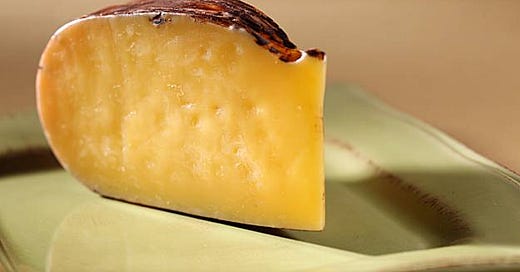ISSUE 67, ARK OF TASTE, Part 3: Dry Monterey Jack Cheese
Dry Monterey Jack Cheese
Now over a century old, the Sonoma Valley’s famous hard cheese, Dry Monterey Jack, came into existence because of supply disruptions during the First World War. Italian and Hispanic communities on the West Coast, while they would buy local “fresh cheeses,” imported their aged grating cheese from Europe. When the War ended these importations, San Francisco wholesaler D. F. DiBernardi while casting about for a source for dry grating cheese, recalled an oversupply of wheels of cow’s milk cheese that he had warehoused in 1915. It has been neglected for a year and a half. The wheels had hardened, mellowed and deepened and flavor, and developing a flakey granular texture. Customers immediately embraced this aged cheese as a substitute for the Parmesan and Grana called for in traditional dishes. Dry Jack Cheese became a market variety.
Monterey Jack, the cow’s milk cheese that had been warehoused, was a well estsablished California variety, manufactured since 1882. Scotsman David Jacks had refined the traditional cows milk formula for queso del pais, in the dairy country of Monterey, south of San Francisco [“Spring is the Season for Fresh Cheese,” San Francisco Chronicle (March 25, 1998), 127.] A soft, pale cheese, Jacks drew on 14 dairy forms for his milk, branded his product with a truncated version of his last name, and marketed it San Francisco and Sacramento with great success. Originally made of raw milk, both Monterey Jack and Dry Monterey Jack Cheese have been made of pasteurized milk since the 1930s. Dry Jack, after DiBernardi launched the variety, inspired dozens of artisans to make versions. The Great Depression and the market incursions of cheap South American grating cheese narrowed the manufacturers. In the 1960s there were eight makers. By the final decades of the twentieth century there were only two manufacturers: Vella Cheese of Sonoma and Rumiano Cheese (founded in 1921 and the producer of the Sonoma Cheese Factory’s Cheese as well as its own brand). With the rise of artisanal cheese making in the 2100s, small scale makers have surfaced.
The Vella Cheese Company has been the most visible champion of Dry Jack for the past four decades. Two immigrant brothers, Joe and Tom Vella, made the Sonoma Valley a center of cheese making. Joe, the first two open a business, made Monterey Jack, but not Dry Jack. His brother Tom (Gaetano) was an employee. He ceased operating during World War II. [Jane Benet, “California’s Own Cheese,” San Francisco Chronicle (October 11, 1972), 19.] Tom Vella organized the Vella Cheese Company in 1931 in a defunct brewery (Prohibition at work). A devotee of Dry Jack, Tom Vella sought the surviving figures from both David Jacks and B. DiBernardi’s enterprises, learning the formulations. DiBernardi’s oil curing of the wheels of Jack. This prompted Tom Vella to create his own signature coating. After brining the muslin coated wheels of cheese three days, he mixed cocoa, black pepper, and vegetable oil, coating the cheese in this dark coating.
Over the years Tom Vella and son and successor Ignazio “Ig” Vella have revealed a good deal about how they make their famous cheese. Milk from grass fed cows—two parts Holstein to one part Guernsey in every batch. Rennet causes the milk to curdle, and the curd knife cuts the batch into chunks. “After the cheese curd is cooked, drained, washed and very lightly salted, it is scooped into muslin sacks. . . . Next, the cheese is pressed, gently, on a hand operated press to expel more whey, and at the same time, give the cheese its final wheel-shaped form. Hand-pressing results in a Monterey that has a creamier texture” [“Diligent work produces ‘genuine masterpiece’ of a Monterey Jack, Las Vegas Review-Journal (January 2, 19850, 44]. Standard Monterey Jack is aged for 45 days. Vella’s Dry Jack underwent “several days of brining and weeks of air drying” and “the wheels are rubbed with Vella’s signature cure, a mixture of soybean or safflower oil, black pepper and unsweetened cocoa. The oil keeps the wheels from cracking, but Tom Vella hatched the idea 50 years ago of adding the pepper and cocoa to keep the oil in suspension and preventing it from penetrating the cheese,” [Janet Fletcher, “Vella’s Dry Jack’s dark Coat Makes an Instant Impression,” San Francisco Chronicle (December 9, 2004), 73.]
Like aged Goudas and Cheddars, Dry Jack is offered with varying lengths of aging. Vella has offered three ages—a basic 7 month minimum aging, and Mezzo Secco, one year aging, and the premium “Golden Bear Flag” 2 year aging. Rumiano Cheese offers a Dry Jack aged 12 months, and the Sonoma Cheese Factory, a nine month offering. While numbers of companies have long added hot peppers to Monterey Jack—Kraft even had a Pepper Jack Cheese at one juncture—the Vellas and Rumianos have not made dry jalepeno and Habenero cheeses. Thought the death of Ig Vella in 2018 caused hand wringing about the future of Dry Jack, both the Vella Company and the Rumiano Company have talented family members who have stepped up to lead them into the future.
Yet truth be told Dry Jack will have a future because of one thing more than any other: its flavor. It is not sharp like Parmesan and Cheddar, nor overly salty. It is mellow, nutty, with a decided sweet tinge, and increasing depth of flavor with increasing age. In West Coast cookery it has been incorporated into a wide range of dishes from béchamel sauce to the core of chili rellenos.
Links:
Vella Cheese Company:
http://vellacheese.com
Rumiano Cheese:
http://rumianocheese.com




